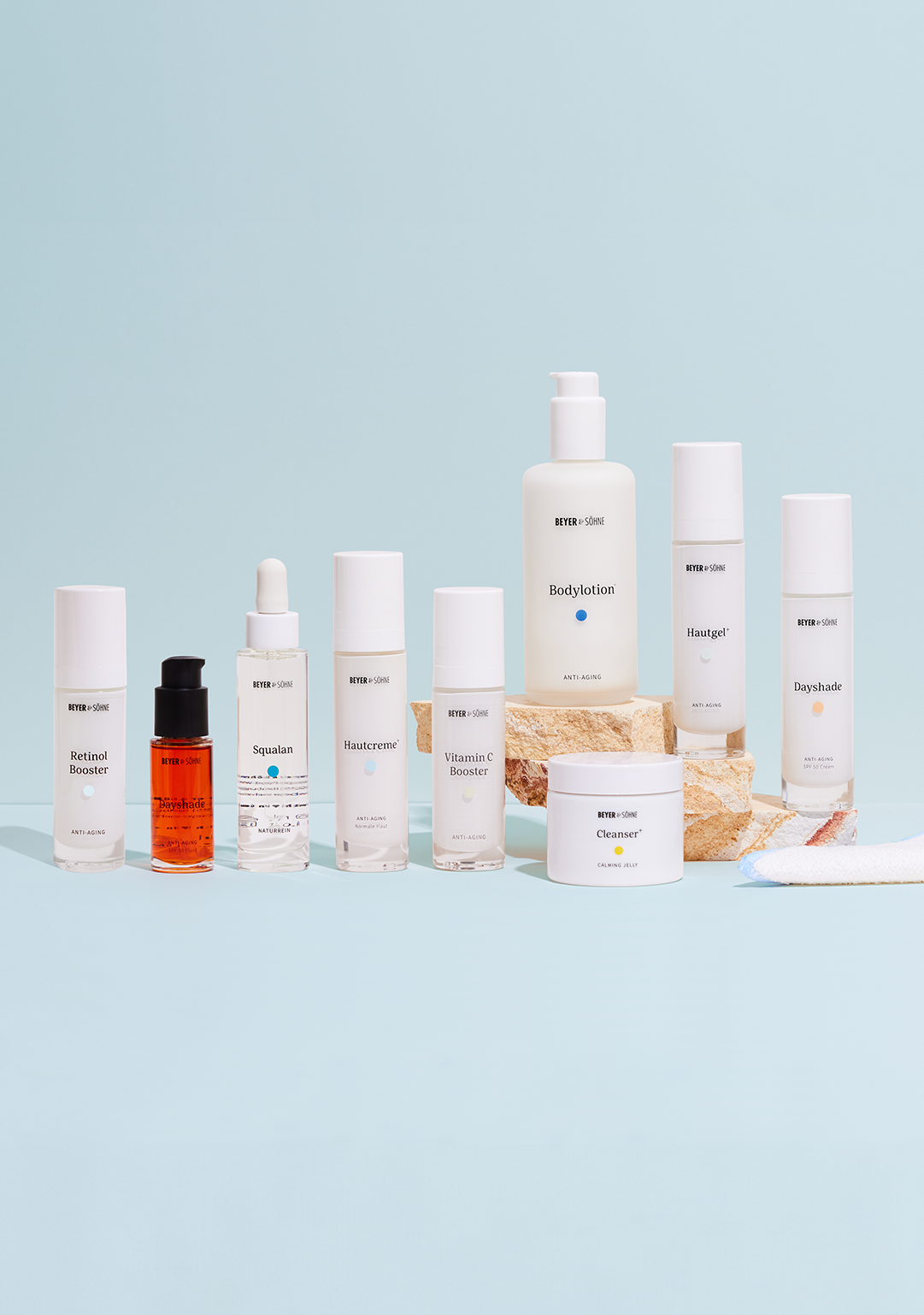Skin Reaction to Sun Rays
Sun Allergy: How to Recognize, Prevent and Treat It
Identifying a sun allergy is quite straightforward. If you've been in the sun and experience a skin reaction afterward, you likely have a sun allergy. However, the symptoms can manifest in various ways—pimples, pustules, nodules, or welts, with or without itching. Determining the exact cause is often challenging. This article delves into the details, shedding light on the diverse manifestations of sun allergies. Additionally, we'll guide you on preventing sun allergies and recommend sunscreens that provide effective protection while being gentle on your skin.

Robby Beyer
September 2024

Table of Contents
What Causes a Sun Allergy?
Unknown Cause: Mallorca Acne and Solar Urticaria
Known Cause: Photoallergic Light Dermatosis
What Triggers a Sun Allergy?
Preventing Sun Allergies: 2 Tips
1. Start Slowly in Spring
2. Protect Yourself from the Sun
What is the Right Sunscreen for Sun Allergy?
Caution: Avoid Fragrances and Certain UV Filters (Octocrylene)
Opt for Tolerant UV Filters
Ideal for Sun Allergy: Dayshade by Beyer & Söhne
Crucial for Sun Allergy: Vitamins and Antioxidants
UVA and UVB Protection: Better Safe Than Sorry
Home Remedies and Cortisone – What Helps with Sun Allergy?
Conclusion
What Causes a Sun Allergy?
The causes of sun allergies are diverse and challenging to pinpoint. Sun allergies are particularly prevalent among children and adolescents but can also emerge in adulthood.
Sun allergy presents in numerous subtypes and variations, leaving the medical community often uncertain about its origins. The most common form of sun allergy even encapsulates its mystery in the name—
idiopathic polymorphic light eruption
. To break it down:
Idiopathic:
Without a known cause
Polymorphic:
Exhibiting various symptoms
Light Eruption:
Inflammation of the skin caused by sunlight
Clear as sunlight, right? Or perhaps not... So, when a doctor tells you, "This is an idiopathic polymorphic light eruption," it essentially translates to, "This is skin inflammation caused by sunlight, but I can't pinpoint the exact cause."
In most cases, it is difficult to determine the source of skin reactions. Moreover, every case of sun allergy may also be referred to as photosensitivity rash or photoallergy.
Unknown Cause: Mallorca Acne and Solar Urticaria
The most prominent manifestation of sun allergy is acne aestivalis also known as "
mallorca acne
," which is also a subtype of polymorphic light eruption. Remarkably, this subtype is relatively easy to identify. It results in the formation of small nodules or blisters beneath the skin. These formations are firm, non-purulent, and do not develop into pimples or pustules. Mallorca acne typically occurs in the spring after the skin has had a long break from sun exposure.

The most well-known form of sun allergy is mallorca acne
Solar urticaria
is a form of hives triggered by sunlight. It results in the typical welts that are also seen in ordinary urticaria. Similar to other forms of sun allergy, pinpointing the exact cause of the reaction in solar urticaria is often challenging.
Known Cause: Photoallergic Light Dermatosis
When the specific substance triggering an allergic reaction is identified, it is referred to as photoallergic light dermatosis. Understanding the cause is advantageous; however, the array of potential allergens can sometimes make identification challenging.
What Triggers a Sun Allergy?
Common triggers for sun allergies include both cosmetic ingredients and medications. Complications arise in cases of cross-allergies with well-known allergens such as birch, grasses, or pollen. Unfortunately, the possibilities are numerous.
For those seeking a deeper understanding, we recommend referring to the overview in the Ärzteblatt titled
'Lichtdermatosen: Diagnostik und Therapie'
(Light Dermatoses: Diagnosis and Therapy). In the following, we'll focus on general tips on the topic and not delve into the numerous manifestations and subtypes.
Preventing Sun Allergies: 2 Tips
1. Start Slowly in Spring
The most common time for the onset of sun allergies is spring. For certain forms like mallorca acne, the initial days and hours of sun exposure are critical. Once the skin has acclimated to sunlight and gained a bit of a tan, the symptoms often subside. While this may not be true for every sun allergy, it's advisable not to bask in the sun right away, even with high sun protection. This brings us to the second tip.
2. Protect Yourself from the Sun
Well, this goes without saying. Especially if you've experienced reactions to the sun before, caution is essential. It helps to cover as much skin as possible with clothing (preferably with built-in sun protection). Exposed areas should be generously coated with reliable sunscreen. Of course, never reuse products that have caused issues in the past. As selecting the right sunscreen for sun allergies can be challenging, we've compiled the essential points for you in the following paragraph.
What is the Right Sunscreen for Sun Allergy?
Choosing the appropriate sunscreen for sun allergy depends on both what is absent from the sunscreen and its ability to provide secure, well-tolerated protection while optimally supporting the skin.
Caution: Avoid Fragrances and Certain UV Filters (Octocrylene)
It's crucial to steer clear of fragrances and certain UV filters. Fragrances can have phototoxic effects and, in the worst case, may contribute to allergies and age spots. Hence, they have no place in a sunscreen, particularly for those prone to sun allergies. While allergies to UV filters are relatively rare, it is still advisable to avoid filters like
Octocrylene
and any filters ending in "
-cinnamate
," such as
Isoamyl P-Methoxycinnamate
and
Octyl Methoxycinnamate
.
Opt for Tolerant UV Filters
Physiological UV filters like
zinc oxide
or
titanium dioxide
offer secure and well-tolerated protection. These filters are generally inert and do not irritate the skin, making them suitable for individuals with sun allergies. Additionally, there are chemical filters that are suitable for sun allergy. What precisely distinguishes UV filters? And which filters are considered harmless? Find out in this article.
Ideal for Sun Allergy: Dayshade by Beyer & Söhne
We offer two products with well-tolerated formulations that are excellent for sun allergy:
Dayshade SPF 50
is a silky oil-fluid containing a special selection of skin-friendly UV filters.
Dayshade Cream SPF 30
is a daily care product with high UVA protection and a wealth of nourishing ingredients that also combat skin aging.
Crucial for Sun Allergy: Vitamins and Antioxidants
If your sunscreen includes
panthenol
,
vitamin C
, or
vitamin E
, that's a significant advantage. These natural antioxidants provide additional protection against the harmful effects of UV rays. Panthenol aids in skin regeneration, vitamin C protects the skin from micro-inflammations, and vitamin E immediately helps alleviate inflammation caused by sun exposure. In some cases, this can even prevent the onset of sun allergies. Interestingly, these minor inflammations are also the cause of sunburn.
UVA and UVB Protection: Better Safe Than Sorry
Both UVA and UVB rays can lead to sun allergies. It's crucial that your sunscreen protects against both types of sun rays. Ensure that your sunscreen carries the
UVA seal
on the packaging—simply the letters UVA enclosed in a circle.

This UVA seal should be present on sunscreens designed for sun allergy protection.
Home Remedies and Cortisone – What Helps with Sun Allergy?
The most effective way to alleviate acute itching is with
cortisone-containing ointments
also known as topical steroids or topical corticosteroids. The stronger ones are prescription medications, and for good reason: Cortisone should not be used long-term as it can harm the skin, including thinning it over time. Therefore, we recommend consulting a doctor for severe symptoms—especially if there is blistering.
For milder symptoms, home remedies such as
cold compresses made from yogurt or quark
can be effective. Some people also swear by
aloe vera
, though caution is advised here too, as allergic reactions are possible. However, in our family, it has always been particularly soothing for sunburn.
Since sun allergy involves inflammatory processes, vitamins and antioxidants can also help. They reduce inflammation and aid the skin in healing itself—as the maker of a well-known healing ointment has recognized. Our Bodylotion+ and Hautcreme+ are also perfectly suited for this purpose.
Bodylotion+
strengthens the skin barrier.
Hautcreme+
contains high-dose antioxidants and additional anti-aging ingredients.
Conclusion
The symptoms and causes of sun allergy are so diverse that even the medical field has lost track. If redness, pimples, or pustules appear after sun exposure, caution is crucial. The foremost step is to avoid the sun. Protective clothing, sun hats, sunglasses, etc., are essential in this regard.
Areas of the skin that cannot be covered by clothing should be protected with sunscreen. Mineral UV filters, such as z
inc oxide
and t
itanium dioxide
, are well-suited. However, there are also compatible chemical filters, offering the advantage of not causing whitening and not depositing in the outermost skin layer.
This article was updated in
May 2019
.
Sources
